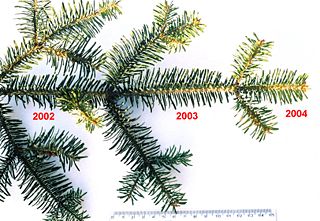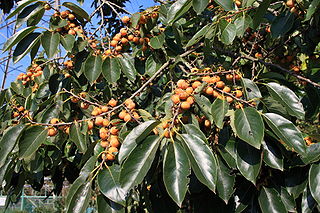
Flowering plants are plants that bear flowers and fruits, and form the clade Angiospermae. The term 'angiosperm' is derived from the Greek words ἀγγεῖον / angeion and σπέρμα / sperma ('seed'), meaning that the seeds are enclosed within a fruit. The group was formerly called Magnoliophyta.

In botany, an evergreen is a plant which has foliage that remains green and functional throughout the year. This contrasts with deciduous plants, which lose their foliage completely during the winter or dry season. Consisting of many different species, the unique feature of evergreen plants lends itself to various environments and purposes.

Cucurbita is a genus of herbaceous fruits in the gourd family, Cucurbitaceae, native to the Andes and Mesoamerica. Five edible species are grown and consumed for their flesh and seeds. They are variously known as squash, pumpkin, or gourd, depending on species, variety, and local parlance. Other kinds of gourd, also called bottle-gourds, are native to Africa and belong to the genus Lagenaria, which is in the same family and subfamily as Cucurbita, but in a different tribe, their young fruits are eaten much like those of the Cucurbita species.

Malvaceae, or the mallows, is a family of flowering plants estimated to contain 244 genera with 4225 known species. Well-known members of economic importance include okra, cotton, cacao, roselle and durian. There are also some genera containing familiar ornamentals, such as Alcea (hollyhock), Malva (mallow), and Tilia. The genera with the largest numbers of species include Hibiscus, Pavonia, Sida, Ayenia, Dombeya, and Sterculia.

Theaceae, the tea family, is a family of flowering plants comprising shrubs and trees, including the economically important tea plant, and the ornamental camellias. It can be described as having from seven to 40 genera, depending on the source and the method of circumscription used. The family Ternstroemiaceae has been included within Theaceae; however, the APG III system of 2009 places it instead in Pentaphylacaceae. Most but not all species are native to China and East Asia.
An EPPO code, formerly known as a Bayer code, is an encoded identifier that is used by the European and Mediterranean Plant Protection Organization (EPPO), in a system designed to uniquely identify organisms – namely plants, pests and pathogens – that are important to agriculture and crop protection. EPPO codes are a core component of a database of names, both scientific and vernacular. Although originally started by the Bayer Corporation, the official list of codes is now maintained by EPPO.

Diospyros lotus, with common names date-plum,Caucasian persimmon, or lilac persimmon, is a widely cultivated species of the genus Diospyros, native to temperate Asia and southeast Europe. Its English name derives from the small fruit, which have a taste reminiscent of both plums and dates. It is among the oldest plants in cultivation.

Callinectes similis, sometimes called the lesser blue crab or dwarf crab, is a West Atlantic species of blue crab. It was described by Austin B. Williams in 1966.

Oreaster reticulatus, commonly known as the red cushion sea star or the West Indian sea star, is a species of marine invertebrate, a starfish in the family Oreasteridae. It is found in shallow water in the western Atlantic Ocean and the Caribbean Sea.

Boea is a genus of plants in the family Gesneriaceae, with species originating from Australia, China, India, Malaysia, Myanmar, Philippines, Polynesia, Solomon Islands, Thailand, Papua New Guinea, Indonesia, Nepal, Bhutan, Cambodia, Vietnam and Laos.
Diospyros areolata is a tree in the family Ebenaceae. The specific epithet areolata means 'net-like', referring to the leaf veins.

Diospyros kurzii is a tree in the family Ebenaceae. It grows up to 30 metres (100 ft) tall. Twigs dry to black. The fruits are ellipsoid, up to 1.2 cm (0.5 in) long. The tree is named for the German botanist and curator W. S. Kurz. Habitat is lowland forests. D. kurzii is found in the Andaman and Nicobar Islands, Burma, Thailand, Peninsular Malaysia, Borneo, the Philippines and Maluku.

Microchirita is a genus of flowering plants in the family Gesneriaceae, subfamily Didymocarpoideae. It contains 48 species native to tropical Asia, ranging from the Indian subcontinent to Indochina, southern China, and Malesia.

The Didymocarpoideae are a subfamily of plants in the family Gesneriaceae. It was formerly the subfamily Cyrtandroideae. This subfamily consists mostly of tropical and subtropical Old World genera, found in Africa, Asia and the Pacific. One species is native to Central and South America.

Dorcoceras is a genus of flowering plants in the African violet family Gesneriaceae, native to Assam, Southeast Asia, China and central Malesia. Its species were transferred from the genus Boea in 2016.
Paraboea are a genus of flowering plants in the African violet family Gesneriaceae, native to southern China, Assam, Indochina, and Malesia. They were recircumscribed from Boea in 2016.

Damrongia is a genus of flowering plants in the Gesneriad family, centered in Thailand and found in southern China, Southeast Asia, and Sumatra. Species were reassigned to it in 2016 in a revision of Loxocarpinae.
Rachunia is a genus of flowering plants belonging to the family Gesneriaceae.

Diospyros rhombifolia, the diamond-leaf persimmon or princess persimmon, is a species of flowering plant in the family Ebenaceae. It is native to southeast China. A shrub or tree reaching 8 m (26 ft), and hardy to USDA zone 7b, it is widely cultivated as an ornamental for its small leaves and attractive orange fruit.
Diospyros toposia is a tree in the family Ebenaceae. The specific epithet toposia is from a local name in India, toposí.














